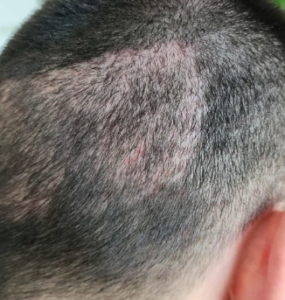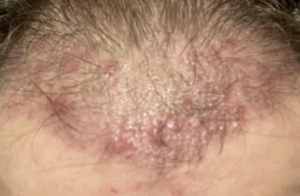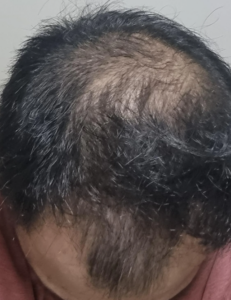Editorial comment from American Journal of Dermatology: Scalp pruritus affected 19% of participants in the topical minoxidil group. Pretibial edema occurred in 4% of participants in the oral minoxidil group. Hypertrichosis was more common with oral minoxidil (27% oral vs 4% topical), although this side effect was mild and well tolerated; 3 participants did not take any action to remove the excess hair, and 5 managed it with waxing. There was no difference between the groups regarding the variation of mean blood pressure over time. The mean heart rate at rest increased 6.5% in the oral minoxidil group without tachycardia; there was no change in the topical minoxidil group. No hypotension-related events occurred. No adverse events in oral minoxidil group required cessation of medication. Our results reveal that low-dose oral minoxidil provides improvement of FPHL that does not differ Table I. Main clinical and demographic data from participants Category Oral minoxidil 1 mg Topical minoxidil 5%……. Research Letters from topical minoxidil 5% solution, with a safe profile and well-tolerated adverse effects. The performance of oral minoxidil in regard to the Sinclair hair shedding score was superior to that of topical minoxidil, reinforcing the favorable results reported with telogen effluvium. The increase in total hair density lay within the topical minoxidil 95% CI; however, if the outcomes are taken together, they suggest a trend toward a greater improvement in the oral minoxidil group. Confirmation of this would require larger and longer studies. In conclusion, oral minoxidil can be considered an option for FPHL patients with poor compliance or who cannot tolerate topical minoxidil.
Doc, how many months would you say if I went on finasteride? Is it needed for a very miniaturized hair to return to its original thick shaft diameter? Thank you.
That varies between people and the aggressiveness of the balding process. In some men, I have seen plucked hairs indicate that the new growth occurred within a month
It is likely over-harvesting, but you must wait this out for 6 months as shock loss will usually reverse itself by then. Let your hair grow out to cover it up. You can use Toppik to cover the problem while it is short. If it doesn’t reverse, then SMP by a good operator will solve the problem. Be sure to view the work of the SMP clinic you find, as seeing is believing and you don’t want to become a victim again if it was overharvested.
I hope that this man didn’t go to Turkey to a clinic there that had no doctor. He needs to see a doctor, and many doctors don’t like to take responsibility for problems like severe folliculitis in recipient grafts if they don’t do the surgery themselves. These grafts will probably not grow in the long term, but if he doesn’t react rapidly to this infection, more grafts may die off, and worse, even he could develop a much more extensive infection. This has many causes, including men who scratch their itchy recipient areas or poor sterile conditions at the time of the transplant. There are many other causes, but these are two of the more prominent causes.
I’m a 44 y/o male, I’ve been told between 4000 in one session or +5000 in two sessions both in FUE, and also been told need FUT, but Im trying to avoid it. My question is if 4000 graphs in one session would suit me (3000 in front/top and 1000 in crown), considering I would be happy with a receding hairline, just not too receded, and I could have a SMP to improve a low density crown area. I’m based in Perth Australia, so I’m considering to get it done in Thailand, Philippines and also Turkiye.
Your frontal area (assuming you have an average hair weight) should take no more than 2000 grafts for a good look. More than that, doesn’t necessarily add value, might just waste your donor hair and put more money in your surgeon’s pocket. Your transplanted hairline should be receded, which is why you are doing it: to look normal. The crown should not be transplanted but instead treated with finasteride, as you have an excellent chance of reversing it. Too many doctors quote too many grafts for reasons that may be financial for them and not good for you.
Yesterday, we did SMP (Scalp Micpigmentation) on a patient whose hair transplant didn’t quite achieve the desired FULLNESS he nor I wanted to achieve. He reached his limit of grafts at about 4000 grafts but still wanted a full head of hair. He had a very large head and a poor donor density. I subsidized his 4000 donor area grafts with 500 beard grafts to the crown in the second of two procedures. This gave him just about enough hair to lightly cover the crown. With SMP, his situation has changed radically, as you can see with the before and after photos taken 4 hours into the SMP, which was still going as this post was written.
This is a wonderful approach when hair fullness (notice I didn’t use the term density) is not achieved. Density is just one element that contributes to the LOOK OF FULLNESS. Other aspects contributing to fullness include the color/contrast between hair and skin color (SMP addresses this very nicely, as shown in this photo below), the thickness of each hair follicle (this man had fine hair reflecting poor hair bulk), and the needs of the balding area (can be expressed in square inches of balding area compared to the donor supply). This man has a Class 7 balding pattern, where a 4:1 imbalance exists between the size of the bald area and the donor area (in his situation, less than half can be used). There is clearly a limit when the graft supply is exhausted.
The patient and I discussed this before the very first procedure, and he went into this with his eyes open because I developed a Personalized Master Plan for him as I started his reconstruction. His first procedure was designed to build a hairline and put enough hair in the frontal 5-6 inches to frame his face and give him some light top coverage. The transplant brought the coverage to mid-scalp. He had a fantastic result and he styled his hair to take advantage of combing it from left to right. The second procedure took it further back to the top and crown. I used beard hair mixed with some scalp hair for this area. In this last procedure 1 year ago, I included some beard hair for his bald crown. When all of this grew in, the back of his head was sparsely covered but with enough hair that a comb-over would suffice. The SMP is the topping to this process as it created the fullness that he desired.
I published an article in 2018 in the Journal of Plastic and Reconstructive Surgery on this philosophy. The theme of this article was that when combining FUE and SMP, the surgeon can almost transplant any healthy man, provided that the donor area is healthy. As this article has been read more often since it was initially published (I receive tracking of the reads), more and more surgeons are adopting this approach in planning a hair reconstruction on men with lower-than-ideal donor densities, fine hair, and advanced balding patterns. This approach requires an excellent team to back up the surgery, including perfection on the SMP side of the equation, as shown in the photo below.
 This photo was taken when only half of the head was done in the mid-point of the procedure.
This photo was taken when only half of the head was done in the mid-point of the procedure.
I’m considering adding SMP after my hair transplant grows for more density, but the blue tint does scare me. Is there any way to solve that?
The blue pigment is created when the ink used is pure black. The inks used must also be mixed with some brown pigments and diluted to avoid this problem.
I don’t have the money for a hair transplant but I am scraping it up and it might take me another year or so. Now I wear a wig to hide my hair. I don’t know what to do. I have been worrying about this since I was 18.
A Hair Transplant is the worst thing you can do before you have a diagnosis and after good medical management. You will need to find a good doctor willing to work with you. You must have a good trichoscopy examination to see if you have Diffuse Unpatterned Alopecia. If this is the case, a hair transplant will never be an option for you, even if you were a man with that condition. Rather than a transplant, the drugs finasteride and oral minoxidil may be considered, along with more powerful anti-androgen drugs, but again, pregnancy runs risks for a child if you were to become pregnant.
3 years on fin, 2 years on min and microneedling with derma roller and switched to dermastamp, not as good results as others I saw here but I wanted to ask what you think was my problem?
Good microneedling requires a controlled amount of damage to induce the healing cascade that brings on hair growth. With the frequently used derma stamps and derma rollers, enough injury is frequently not created to get the best results. That could be the way you are using it. Try the Dr. Pen, 36 needle divide, depth 1.25 mm, and hold it in each area for 10 seconds once a week. That might make a difference.
I was recommended to have 2500 grafts from a clinic, while another one said 1500, I’m not sure which one to go with; is it better to go with more grafts in my case?
There is a huge difference between creating a good, solid female hairline versus a male one. If you are in-between the male and female decision, then designing a hairline is difficult as well as estimating the grafts required. I have done many of these on females, which usually takes more grafts if you want a classical female pattern; however, if you wish to fix a male hairline, then this will be less work.
When you and I review my photos and looked at it microscopically over a Zoom call, you said that I had extensive miniaturization on the top and crown of my head. Are these hairs destined to die off and fall out?
When there is extensive miniaturization, the hairs are destined to be lost; however, drugs like finasteride can extend their life for many years, so that is a good option for you.
Is it normal for men to develop slight thinning on the crown but not actually develop a fully bald crown?
If a microscopic examination of your crown shows uniform distribution of miniaturization, then you will eventually (over time) lose all of those hairs. It might take decades. Finasteride works wonders on the crown to reverse this process, even for men in their 70s.
Shaving your head will not make the hair grow where it is not growing well now; however, if you use topical medications, getting them on the scalp will be easier. Only 40% of men will find that minoxidil is effective because their scalp has an enzyme that will interact with it to produce its active form. When applying it, it must get on the scalp. Medication that gets on the hair is wasted.
I noticed recently that biden was ALL bald at the top (sorry for my lack of proper terminology to describe this situation) when he was competing for nomination in the 1980s. But now – come on – he has thinned but at least there are hairs on top. any ideas?
Biden had hair transplants, first in the old days when the pluggy look was all you could get. Sometime since the mid-1990s, he had the old plugs repaired, making his hair look fuller. Also, white hair reflects light, so it always looks fuller than it is. Most of his hair transplants were in the frontal area; little was focused on the crown. This is an excellent strategy when a person is very bald. The focus on the frame to the face by transplanting the frontal 3 inches of the hairline is a strategy that has been around for a long time.
FYI: For information on Trump’s “hair” see:https://baldingblog.com/does-donald-trump-have-an-expenisve-wig/
In 2014 – was 24 years old in between a Norwood III and IV, and underwent a FUE 2700 grafts to mainly cover the front. Didn’t start fin as was apprehensive of the side effects but started minoxidil which I was also inconsistent with over the years. In more recent years (last 5-6 years have been taking Nourkrin man as a supplement and topical Min 5% foam very consistently) In 2016 underwent SMP in London.
The balding area grew as my native hair started falling, while the transplanted hair also got thinner. Used to manage a nice look with the help of hair fibres over the last many years which did wonders. Finally in Feb 2024 (age 34) decided to pull the plug on another HT. Consulted with 3-4 top surgeons and mostly their feedback was consistent with c 2500 grafts available from donor area and another 600-800 from the beard. The clinic I went with managed to extract 2700 from the scalp and 800 from the beard area over 2 days. Total c 3500 grafts. They reconstructed the hairline (one thin line ahead of the earlier transplant area) and temple area along with filling up the midscalp region and sparsely covering the back scalp (the crown was mostly left untouched given the large balding area). I though you wanted to see the views on the work done in terms of look one day post implantation / distance between graft placement? I also realised my mistake of not starting fin (more mature now!) – hence have started 1mg a day and hopefully that along with min helps some regrowth along with the new HT to hopefully give a good result! Your thought please?
When you start the hair transplant process before the age of 26, you are looking at more hair transplants because the native hair and your balding pattern may advance with age, as happened in your case. I am surprised that more hair from the hair transplant hasn’t lasted the past 10 years. We see those on occasion; however, this is not that common. Most of my hair transplant patients keep their transplanted hair for a very long time. I have been doing hair transplants for the past 33 years, and some of the men I transplanted in 1992-3 have since visited me with hair on their heads. It is important to note that this man’s donor supply was significantly reduced. SMP is a good procedure, but as you can see from this man’s before picture, the SMP has faded and developed a blue tint. In addition, the individual dots from the SMP have spread out and are no longer little dots. This is common with SMP.
The average man has about 5000-7000 grafts, provided their hair is not fine. If their hair is coarse and their density is at least average, the donor area can supply 8000, possibly more, grafts. Fine hair does not produce much bulk, so donor site depletion is common in fine-haired individuals especially with FUE. For those reading this post, the message is to be sure to ask your surgeon to discuss your original donor density, hair mass, and total donor supply for your lifetime before undergoing a hair transplant. The distribution of the grafts was appropriate, with more density up front; however, considering the extent of the transplants I see, I wonder how this man’s donor supply will look in terms of over-harvesting.







